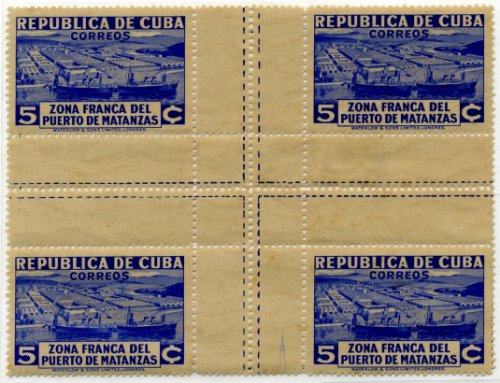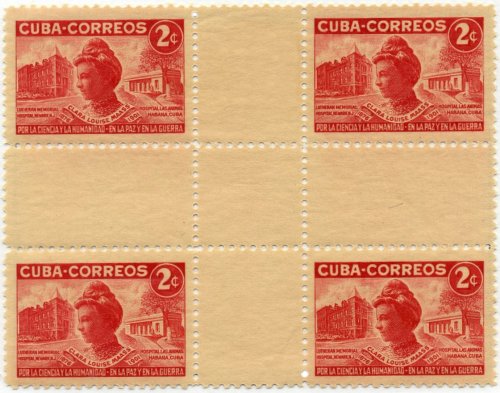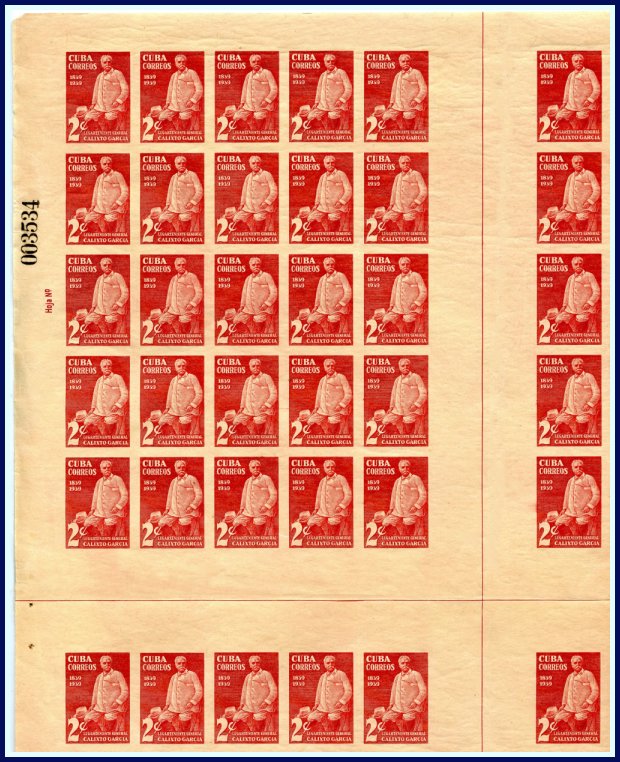
One of my pleasures in Cuban philately is one perhaps overlooked by others. I have pursued the collection of centros de hoja. Between the years 1926 and 1952 there were 160 sheets of stamps produced in Cuba that had intersecting gutters between 4 panes of stamps. After the patriot series of 1926 which had 400 stamps in panes of 100, the number of stamps in a sheet was uniformly set at 100 in four panes of 25 stamps each.
Most of the centros de hoja were commemorative issues with 3 definitives, 24 airmail, 4 special delivery (Port of Matanzas, Association of Writers and Artists, the flag sesquicentennial and the 1952 Figueredo overprint) and one airmail special delivery (Scott CE1 Port of Matanzas).

How many sheets were issued? A 2¢ stamp was the standard postage for much of the time period of the centros de hoja, and produced the most sheets. As many as 3,200 sheets of 100 stamps were issued for many of the Communications Workers' Retirement series. In 1948, as few as 250 sheets of the one peso "Death of Antonio Maceo" were printed. The entire imperforate 1936 Matanzas series, all 14 stamps, was printed in a limited edition of 200 sheets, each with 100 stamps divided into four panes of 25 stamps separated by horizontal and vertical gutters. According to Sergio Cano, the prominent Cuban stamp dealer, at the time nobody collected sheet centers because none existed except for the 1926 imperforate patriots issue, so many of the Matanzas sheets were cut into blocks of 25 to facilitate their sale, thus destroying the center block. How many centros de hoja survived is anybody's guess.
It is hard to discern what the criteria was to rate this type of printing with intersecting gutters. A little over half of the stamps issued between 1926 and 1952 were printed with centros de hoja. Nineteen were imperforate including 14 Matanzas; the rest were not. Even within a series of eight stamps issued on the same day, two such series were printed with one having no centro de hoja: the Maceo centennial (1948) series has no 20¢ centro de hoja and the Cuban flag sesquicentennial series (1951) has no 5¢ ordinary mail centro de hoja although it does have a 5¢ airmail.
The first three issues were the 1926 imperforate patriots – Marti, Gomez and García – which had narrow gutters and thin continuous lines. This was followed 10 years later by the Port of Matanzas series which was divided by a double dashed line instead of a single continuous line. This was unique in not only the double line, but also the gutter itself was perforated down the center as well as at the edges of the stamps. Gutters on subsequent issues were wider and appeared with or without a single continuous dividing line along their center. In some issues a design was incorporated at the center of the complete sheet of four panes where the horizontal and vertical gutters crossed.
The Association of Writers and Artists series has two stamps on each centro de hoja except for the 25¢ ship. The series was issued in sheets of 100 stamps divided by gutters into four panels of 25 stamps each. A single sheet had fifty of one stamp and fifty of another design of the same value. Sales of the stamp benefited the Association, but the issues were sold only for three days, then withdrawn. Although 7,500 sheets of the most popular 2¢ stamps were printed, only 108,000 stamps, equivalent to 1,080 sheets, were sold in the three days. The least popular in the set, the 20¢ airmail (Uruguay and Venezuela) had 2,500 sheets printed, but sold only 17,850 stamps, equivalent to 178 sheets.
Sheets were really dressed up in 1940-41; they were given a special emblem or writing in the center of the intersecting gutters. Those special issues were for the Rotary Club International Convention, the Lions Club International Convention, the Centennial of postage stamps and the Guillermo Moncada centennial which decorated the 3¢ and 5¢ issues.
The last of the series were the coffee issues of 1952. Although some claim the 1960 Christmas issue as centros de hoja, I do not. To me those are "special format" sheets without gutters dividing four sheets of stamps. In place of the gutters is an entirely different stamp which divides the others on the sheet. I have no idea why Cuban stamps ceased to be printed in four panes divided by horizontal and vertical gutters that prompted the collecting of sheet centers. I find them fascinating. I will continue my hunt for these elusive treasures.
What follows is a table listing the centros de hoja in my collection. Each listing is linked to the scan of that particular centro de hoja. Use the back button on your browser to get back to this table.
Una de mis áreas favoritas en la filatelia cubana pasa frecuentemente desapercibida por otros coleccionistas--se trata de los Centros de Hoja. Entre los años 1926 y 1952 se produjeron en Cuba 160 sellos en hojas divididas en cuatro paneles por bandas en blanco que se intersectan en el centro. Después de la serie de los patriotas de 1926, cuyas hojas de 400 sellos estaban divididas en 4 paneles de 100, el número de sellos en cada hoja se fijó en 100 sellos divididos en cuatro paneles de 25 sellos cada uno.
La mayor parte de los Centros de Hoja fueron sellos conmemorativos con 3 sellos regulares, 24 aéreos, 4 de entrega especial (Puerto de Matanzas, Asociación de Escritores y Artistas, Centenario de la Bandera y 1952 Figueredo habilitado) y un sello de entrega especial aéreo (el sello Scott CE1 del Puerto de Matanzas).

¿Cuantas hojas se emitieron? Durante casi todo el período de los Centros de Hoja el franqueo de una carta sencilla fue de 2 centavos y por eso muchos de los Centros de Hoja son sellos de ese valor. Se emitieron hasta 3200 hojas de 100 sellos para muchas de las series del Retiro de Comunicaciones. En 1948 sin embargo nada más se imprimieron 250 hojas del valor de un peso conmemorando "La Muerte de Antonio Maceo". Resulta imposible determinar cuántos Centros de Hoja de ese sello sobrevivieron.
Es difícil discernir cuál fue el criterio que se usó para imprimir algunos sellos con Centros de Hoja. Un poco más de la mitad de los sellos emitidos entre 1926 y 1952 se imprimieron con Centros de Hoja. Diecinueve fueron sellos sin perforaciones, incluyendo 14 de la serie de Matanzas; el resto fueron sellos con dientes. Inclusive en dos series de ocho sellos emitidos en el mismo día uno de los valores no tiene Centro de Hoja: en la serie del Centenario de Maceo (1948), el valor de 20 centavos no tiene Centro de Hoja y en la serie del Centenario de la Bandera Cubana el valor de 5 centavos para el correo regular tampoco tiene Centro de Hoja—a pesar de que el valor de 5 centavos para el correo aéreo sí lo tiene.
Los primeros Centros de Hoja de 1926 conmemorando a los patriotas Martí, Gómez y García eran sellos sin perforar y los paneles de sellos estaban divididos por una franja blanca estrecha con una línea contínua a lo largo del centro de la franja. A éstos les siguió diez años más tarde la serie del Puerto de Matanzas donde las franjas blancas dividiendo los paneles de sellos presentan dos líneas de rayitas intermitentes en vez de una raya contínua. En emisiones siguientes las franjas divisorias de los paneles de sellos (franjas interpaneles) fueron más anchas con una raya divisoria contínua al centro o sin ella. En algunas emisiones también se añadió un diseño en el centro de la hoja de cuatro paneles donde se cruzan la franja interpanel horizontal con la vertical.
La serie de la Asociación de Escritores y Artistas se emitió en hojas de 100 sellos divididas en cuatro paneles de 25 sellos cada uno. Cada valor de la serie consta de dos diseños, imprimiéndose una mitad de la hoja con dos paneles del mismo diseño y la otra mitad con el otro diseño, de manera que cada Centro de Hoja muestra dos diseños de cada valor excepto el valor de 25 centavos que se imprimió solo en una hoja de 100 sellos. Las ventas de esta serie fueron a favor de la Asociación, pero solo se vendieron estos sellos durante tres días y luego se retiraron de la venta. A pesar de que se imprimieron 7500 hojas del valor más popular de 2 centavos, solo se vendieron 108,000 sellos durante los tres días que estuvieron a la venta, equivalentes a 1080 hojas. El sello menos popular de la serie, el valor de 20 centavos para el correo aéreo (con diseños correspondientes a Uruguay y Venezuela) tuvo una tirada de 2500 hojas, pero solo se vendieron 17,850 sellos, equivalentes a 178 hojas.
Las hojas se adornaron en los años 1940 y 41 con un emblema especial en el centro de las hojas. Estas emisiones especiales fueron las de la Convención Internacional del Club de Rotarios, la Convención Internacional del Club de Leones, el Centenario del Sello Postal y el Centenario del General Guillermo Moncada.
Los últimos centros de hoja de Cuba fueron los de la serie del café de 1952. Algunos incluyen los centros de las hojas de la serie de las Navidades de 1960 dentro de las colecciones de centros de hoja de Cuba, pero yo no. Para mí esas son hojas de formato especial sin interpaneles horizontales ni verticales dividiendo cuatro hojas impresas conjuntamente. No sé por qué se descontinuaron imprimiendo los sellos cubanos en cuatro paneles divididos por los interpaneles horizontales y verticales que motivaron el coleccionismo de los centros de esas hojas. Yo los encuentro fascinantes y continuaré a la caza de estos tesoros de la filatelia cubana.
A continuación les presento una lista de los Centros de Hoja de mi colección. Cada elemento de la lista está enlazado a las imágenesde los Centros de Hoja que se describen. Para volver a la lista, use el botón de retorno de su browser.
